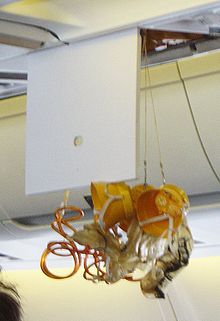Commercial aviation: Difference between revisions
m →Emergency oxygen systems: General fixes / CHECKWIKI fixes / Interwiki Link Duplication using AWB (8323) |
|||
| Line 20: | Line 20: | ||
In the early years of commercial flight, before pressurized cabins were invented, airliner passengers sometimes had to wear oxygen masks during routine flights. |
In the early years of commercial flight, before pressurized cabins were invented, airliner passengers sometimes had to wear oxygen masks during routine flights. |
||
Oxygen is good for survival it helps me live. |
|||
== See also == |
== See also == |
||
Revision as of 19:32, 4 December 2012

Commercial aviation is the part of civil aviation (both general aviation and scheduled airline service) that involves operating aircraft for hire to transport passengers or cargo. In most countries, a flight may be operated for money only if it meets three criteria:
- the pilot must hold a valid commercial pilot's certificate
- the aircraft must hold a valid commercial registration
- the operator must hold a certificate or some other authorization for commercial operations
There are some exceptions — for example, a flight instructor is normally allowed to fly for money in a private aircraft owned by the student — but the above requirements hold for most flights where money changes hands.
Typically, a commercial certificate or registration requires higher standards than a private one. For example, a commercial pilot may have to demonstrate more maneuvers to a higher standard, and may need to pass more frequent medical examinations. A commercially registered plane may require more frequent or more extensive maintenance.
It is the purpose of the flight, not the type of aircraft or pilot, that determines whether the flight is commercial. For example, a two-seat Cessna 150 towing a banner for money would be a commercial flight, while a large jet flown by its owners for a private vacation would not be, even if the pilots were commercially certificated and the jet were commercially registered.
Emergency oxygen systems

Most commercial aircraft are fitted with oxygen masks for use when cabin pressurization fails.[1][2] In general, commercial aircraft are pressurized so that the cabin air is at a pressure equivalent to no more than 8,000 feet altitude (usually somewhat lower altitude), where one can breathe normally without an oxygen mask. If the oxygen pressure in the cabin drops below a safe level, risking hypoxia, compartments containing the oxygen masks will open automatically, either above or in front of the passenger and crew seats, and in the lavatories.
In the early years of commercial flight, before pressurized cabins were invented, airliner passengers sometimes had to wear oxygen masks during routine flights. Oxygen is good for survival it helps me live.
See also
References
- ^ Brantigan JW (1980). "Investigation of flow rates of oxygen systems used in general aviation". Aviat Space Environ Med. 51 (3): 293–4. PMID 6444812.
{{cite journal}}: Unknown parameter|month=ignored (help) - ^ Olson RM (1976). "Economical oxygen-delivery system". Aviat Space Environ Med. 47 (4): 449–51. PMID 1275837.
{{cite journal}}: Unknown parameter|month=ignored (help)
